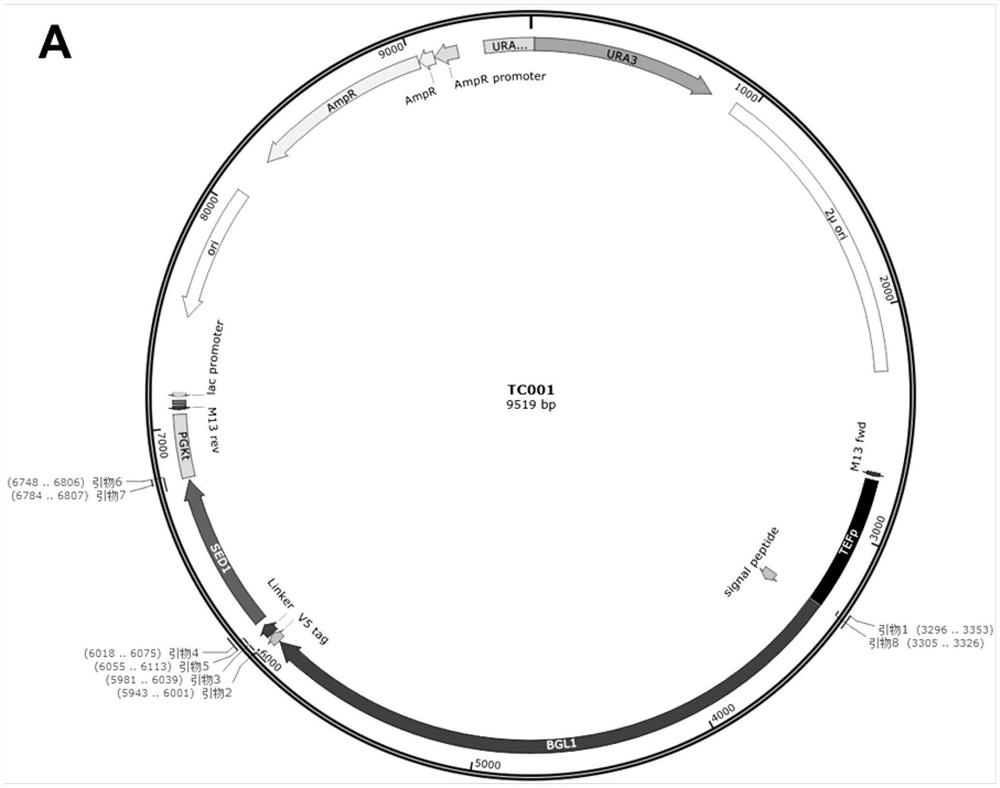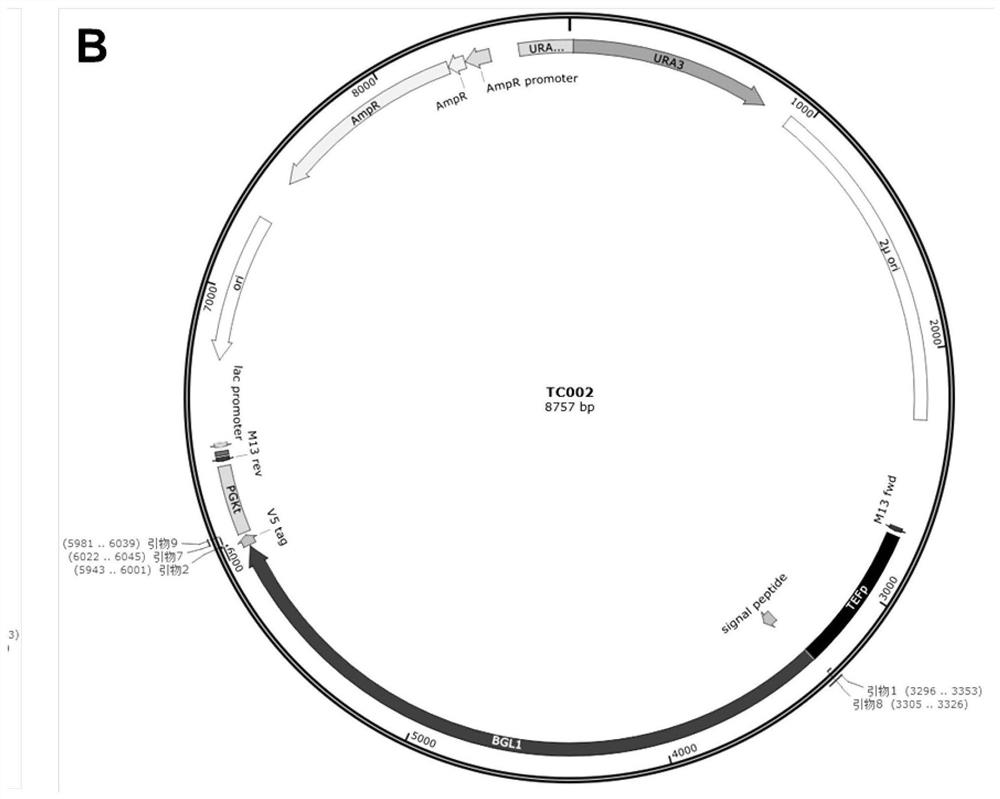Method for improving secretion or surface display expression of heterologous protein in saccharomyces cerevisiae
A heterologous protein, surface display technology, applied in the field of recombinant Saccharomyces cerevisiae strains and its construction, to achieve the effect of improving production costs
- Summary
- Abstract
- Description
- Claims
- Application Information
AI Technical Summary
Problems solved by technology
Method used
Image
Examples
Embodiment 1
[0037] Example 1 Construction of cellulase β-glucosidase recombinant plasmid
[0038] Taking the cellulase β-glucosidase (β-glucosidase, BGL1) derived from Saccharomycopsis fibuligera as an example, the function of β-glucosidase is to hydrolyze cellobiose to generate glucose. The BGL1 sequence was used as a template, and primers 1 and 2 / 3 / 4 were used for three rounds of PCR amplification to obtain the β-glucosidase fragment 1 containing the V5 tag and connecting sequence. Template amplifies SED1 surface display fragment 2, and then amplifies plasmid backbone fragment 3 with primer 7 and primer 8, and assembles fragment 1, fragment 2, and fragment 3 by the Gibson Assembly method to construct a surface-displayed recombinant plasmid TC001 (such as figure 1 A); Utilize primer 1 and primer 2 / 9 to amplify the secreted β-glucosidase fragment 4, and fragment 3 and fragment 4 are assembled by Gibson Assembly method to construct recombinant plasmid TC002 (such as figure 1 B). Recombin...
Embodiment 2
[0049] Example 2 Preparation of recombinant Saccharomyces cerevisiae library of BGL1 display type and secretory expression
[0050] The obtained recombinant plasmids TC001 and TC002 were respectively transformed into the Saccharomyces cerevisiae knockout library (commercialized) that inactivated cell wall-related proteins, and the inactivated cell wall-related proteins were DFG5, YPS7, TIR1, FKS1, NPP1, LDB17, CCW12, SHE10 , CWP2 and PRY3. The specific steps are as follows: Pick the yeast into 96-well deep-well plates containing 300 μL YEPD medium, activate at 30°C for 36 h, transfer to 500 μL YEPD medium, and dilute 20 times to make the initial OD600 about 0.2, Cultivate at 30°C until the OD600 is between 0.7-1.0, centrifuge at 5000rpm for 5min to remove the YEPD medium, resuspend the cell pellet with 500μL sterile water, centrifuge at 5000rpm for 5min to remove the supernatant, then resuspend the cell pellet with 500μL 100mM LiAC, centrifuge at 5000rpm for 5min Remove the s...
Embodiment 3
[0051] Example 3 Screening of cell wall elements
[0052] In order to screen cell wall elements that can increase the expression of heterologous proteins in Saccharomyces cerevisiae, each unit yeast in the recombinant S. Activation in a 96-well deep-well plate containing 300 μL SC-URA liquid medium for 36 hours, and then diluted 20 times in 600 μL SC-URA liquid medium (1.7g / L amino-free yeast nitrogen source, 5g / L ammonium sulfate, 20g / L D-glucose, 190mg / L arginine, 52mg / L tyrosine, 108mg / L methionine, 290mg / L isoleucine, 440mg / L lysine, 200mg / L phenylalanine, 400mg / L L aspartic acid, 1260mg / L glutamic acid, 380mg / L valine, 220mg / L threonine, 400mg / L leucine, 130mg / L glycine, 40mg / L tryptophan and 140mg / L group Amino acid) in a 96-well deep-well plate, cultured at 30°C for 24 hours to obtain a culture solution containing the heterologous protein BGL1, and carried out the next step of enzyme activity determination. First, the standard curve of the substrate pNP was drawn, an...
PUM
 Login to View More
Login to View More Abstract
Description
Claims
Application Information
 Login to View More
Login to View More - R&D
- Intellectual Property
- Life Sciences
- Materials
- Tech Scout
- Unparalleled Data Quality
- Higher Quality Content
- 60% Fewer Hallucinations
Browse by: Latest US Patents, China's latest patents, Technical Efficacy Thesaurus, Application Domain, Technology Topic, Popular Technical Reports.
© 2025 PatSnap. All rights reserved.Legal|Privacy policy|Modern Slavery Act Transparency Statement|Sitemap|About US| Contact US: help@patsnap.com



